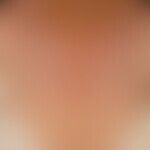Synonym(s)
DefinitionThis section has been translated automatically.
Chronic, localized or generalized skin disease in which intrinsic or extrinsic factors lead to the destruction of melanocytes in the epidermis (and hair follicles) and thus to the loss of hereditary skin color, which manifests clinically as localized, but also generalized, patchy depigmentation of the skin and/or mucous membranes.
ClassificationThis section has been translated automatically.
A distinction is made according to clinical distribution and localization:
- Vitiligo vulgaris (non-segmental vitiligo): The onset is usually symmetrical and often periorificial in 78% of patients.
- Focal vitiligo: 14% of patients
- Segmental vitiligo: 5% of patients (usually unisegmental, more rarely bi- or multisegmental - probably with segmental but cutaneous mosaic dermatosis).
- Acrofacial vitiligo: 2% of patients.
- Vitiligo of the mucous membrane: 0.5% of patients.
- Vitiligo universalis: 0.5% of patients.
Depending on the onset of the disease, a further subdivision of vitiligo can be made:
- Type I (prepubertal vitiligo): Onset of vitiligo before puberty. Familial accumulation of vitiligo, gray hair and other autoimmune diseases; frequent atopic eczema and halo nevi. Infestation of the trunk and limbs.
- Type II (post-pubertal vitiligo): Infestation of the acra and face.
An assessment of the clinical activity of the vitiligo in the last 12 months is important for a treatment decision:
- Vitiligo with a stable course
- Vitiligo with continuous or relapsing progression
- Inflammatory vitiligo (erythema forms at the edge of the vitiligo due to a local inflammatory reaction)
You might also be interested in
Occurrence/EpidemiologyThis section has been translated automatically.
Prevalence: 0.5-2.0% of the Caucasian population; 2.0-4.0% of the Indian, Arab, African and Asian population. Familial clustering is observed in about 30% of cases.
Vitiligo can also occur as part of complex syndromes:
EtiopathogenesisThis section has been translated automatically.
Unknown. Many authors consider non-segmental vitiligo to be an inflammatory systemic disease.
An immunological or autoimmunological pathogenesis is discussed. It is assumed that overactivity of the JAK signaling pathway promotes inflammatory processes, which in turn are involved in the development and progression of vitiligo.
There is evidence of a correlation between increased serum concentrations of the chemokines CXCL9 and CXCL10 and the progression of vitiligo. CXCL10 may be a biomarker for the severity of vitiligo.
A hereditary disposition to the disease exists in up to 35% of patients.
Isomorphism(Köbner phenomenon) is detected in up to 40% of patients (sunburns, physical, chemical or mechanical trauma, topical application of diphencyprones, accidental skin contact with solvents or pesticides)
Other triggers: psychological stress, thyrotoxicosis.
A connection between vitiligo - diabetes mellitus and hypertension is being discussed (Pan Kang et al. 2021)
A constant association with Hashimoto's thyroiditis has been proven.
Triggering drugs: beta-blockers, statins, tetracyclines, hydroquinone; dupilumab
Random, inconstant associations exist with pernicious anemia, Addison's disease, alopecia areata, lupus erythematosus, autoantibodies against parietal cells of the stomach and adrenal cortex, malignant melanoma, pemphigus vulgaris, diabetes mellitus, myasthenia gravis, biliary cirrhosis, see also polyendocrinological syndrome, autoimmunological.
Genetic studies have revealed a number of polymorphisms in susceptibility genes of congenital (e.g. NLRP1/is increasingly expressed in perilesional vitiligo skin, CASP7) and adaptive immunity (e.g. HLA class I; IL2R, FOXP3), but also of melanogenesis(tyrosinase gene). This predisposition, coupled with other factors (e.g. cytokine growth factor hormone imbalance), results in an increased vulnerability of the melanocytes, which leads to an immunological response (vitiligo melanocytes express tyrosine-related protein-1, which induces autoimmunological reactions) and ultimately to the destruction of the melanocytes.
ManifestationThis section has been translated automatically.
Mostly occurring between the 10th and 30th year of life (in half of the cases before the 20th year of life; in 25% of the cases before the 10th year of life). No sex preference. S.a. under classification (pre- and postpubertal)
LocalizationThis section has been translated automatically.
The face, capillitium(poliosis), neck region, hands, axillary region, nipples, navel and genito-anal region are particularly affected.
ClinicThis section has been translated automatically.
Differently sized, sharply defined, differently configured, white patches, often with hyperpigmented edges (pigment flight into the periphery). In dark skin in particular, several color gradations become visible at the edges (trichrome vitiligo or multichrome vitiligo). There is an increase in the number and size of the white patches, as well as their confluence.
The hair may be white (leukotrichia) in affected areas of the skin. Experience has shown that this pattern of infestation is associated with resistance to theapia.
Perilesional depigmentation may occur around melanocytic nevi(halo or Sutton nevus). In the area of alopecia areata, flat or reticular depigmentation may occur (see illustration).
Circumscribed, white-colored areas of hair may appear on the capillitium (also eyebrows and eyelashes)(poliosis circumscripta)
Depending on the distribution of the foci, a distinction is made between generalized, localized and universal vitiligo (see table); see also Uveomeningoencephalic syndrome. The so-called "segmental vitiligo", which many authors interpret as a cutaneous mosaic, requires special interpretation (Dellatorre G et al. 2023).
Vitiligo is described as "stable" if no new foci appear; unstable = slow increase in size of existing foci or the irregular intermittent appearance of new foci; progressive = continuous progression of existing foci and appearance of new foci (n. Meurer M et al. 2017).
LaboratoryThis section has been translated automatically.
Determination of TSH as well as anti-TPO (elevated in 10%) and anti-thyroglobulin antibodies (elevated in 7.5%; see also under thyroglobulin). ANA are elevated in 5% of the patients. Relatively frequently (16.3%), eosinophilia is detected in the blood count. The relevance of elevated SOX10 serum levels in vitiligo remains to be seen. Further laboratory tests are not helpful.
HistologyThis section has been translated automatically.
No or tyrosinase-negative melanocytes as well as melanin-free basal cells In the early phase of vitiligo development, a perivascular lymphocytic infiltrate is found, with melanocytes still preserved.
Differential diagnosisThis section has been translated automatically.
Clinical:
- Pityriasis versicolor alba: scaling, confetti-like, involvement of seborrheic zones, recurrent course.
- Pityriasis alba: skin dryness, scaling, atopic signs
- Nevus anaemicus: localized, no irritative redness of the focal area after scratch irritation
- Piebaldism: congential, white forelock
- Circumscribed scleroderma: no spot, planar tissue induration. Histology is diagnostic
- Lichen sclerosus et atrophicus: no spot, planar tissue induration. Mostly involvement of the genito anal area. Itching, burning sensation. Histology is diagnostic
- Nevus depigmentosus: congenital, recognizable as a cutaneous mosaic
- Hypomelanosis Ito: congenital,running in the Blaschko lines,
- Leukoderm: condition after previous diseases, often also hyperpigmentation
- Leprosy (rarity in Europe): white mottling with hyp- or anesthesia. Histology is diagnostic
Hypomelanosis guttata: occurring only in UV-exposed skin areas. In individuals > 50 years of age.
Blaschko-linear vitiligo: special form of vitiligo; late-manifested hamartoma of the skin.
Complication(s)(associated diseasesThis section has been translated automatically.
In very rare cases, eye and inner ear involvement may occur (uveitis due to functional impairment of the melanocytes in the stria vascularis; mild sensineural hypoacusis is detectable in around 14% of patients, which usually goes unnoticed in everyday clinical practice).
Vitiligo/psoriasis/atopicdermatitis and COVID-19 infections/vaccines: In a prospective, multicenter, multidisciplinary cohort study, the effects of COVID-19 disease and vaccination on vitiligo, atopic dermatitis and psoriasis (=DIMID = dermatological immune-mediated inflammatory diseases) were investigated (van Buchem-Post NF et al. 2025). COVID-19 was common in patients with vitiligo (51.1 %), AD (42.0 %) and psoriasis (34.3 %). COVID-19 was not associated with the use of immunosuppressive therapy. COVID vaccination: Almost all patients with DIMIDs showed effective seroconversion after regular vaccination (vitiligo 100 %, psoriasis 97.9 %, AD 96.5 %). Increased DIMID activity after COVID-19 vaccination was reported in 12.26% of patients, with progressive disease at baseline (disease activity 3 months before baseline examination) being the only associated risk factor. With regard to COVID-19 infection, no distinct signs of (severe) COVID-19 progression in patients with atopic dermatitis, psoriasis or vitiligo were found in larger cross-sectional studies. Patients with DIMIDs can safely continue their immunosuppressive therapy, as this does not increase the risk of COVID-19, while the humoral responses induced by vaccination are sufficient (van Buchem-Post NF et al. 2025).
Thyroid diseases and diabetes mellitus
TherapyThis section has been translated automatically.
Search for and treatment of any existing underlying disease. Stage-appropriate therapy, see Table 1.
- Glucocorticoids local/intralesional: Positive therapeutic effects with halogenated or fluorinated glucocorticoids (applied locally) such as betamethasone valerate (e.g. Betnesol V cream), clobetasol propionate (e.g. Dermoxin cream, R054 ) and hydrocortisone in creams or ointments R120. Successes have also been described with intralesional injections of triamcinolone acetonide (e.g. Volon A 10-40 mg) in various studies.
- Pimecrolimus: A therapy trial with topical calcineurin inhibitors (e.g. Elidel) can be undertaken ( off-label use). 2x per day over 6 months - study situation not confirmed; strict indication due to unclear long-term side effects). The response rate is comparable with the results of local glucocorticoid therapy. Some authors negate the effects of monotherapy with calcineurin inhibitors.
- Tacrolimus: Good results were achieved in several pilot studies with topically applied tacrolimus (1-2 times/day) Off-label use. The effects are often only temporary. Larger controlled studies are lacking. In a clinical study, a comparably good effect was achieved in comparison with clobetasol-17-propionate.
Tofacitinib: Data on the potential efficacy of JAK inhibitors in vitiligo are available for this preparation, a selective JAK inhibitor (Craiglow BG et al. 2015). JAK inhibitors are preferably used orally. However, there are studies that also demonstrate the topical efficacy of this group of drugs in vitiligo (Ciechanowicz P et al. 2018).
Ruxolitinib: topical JAK inhibitor, indicated for facial involvement with good study results for repigmentation (Rosmarin D et al. 2020/Tavoletti G et al. 2023). Since May 2023, the active ingredient has also been on the German market in the form of a cream (Opzelura®) to support repigmentation in non-segmental vitiligo. Important: JAK/STAT signaling is recognized as a key mediator for many of the effector functions of Trm cells. JAK inhibitors disrupt the IFNgamma signaling pathway and cause skin repigmentation; however, depigmentation returns when treatment is discontinued. It has been shown that the number of established TRM in the skin is not affected by Jak inhibitors in a mouse model of vitiligo, which provides an explanation for why JAK inhibitors do not achieve lasting treatment success (Azzolino V et al. 2020).
Symptomatic: Covering ( camouflage): Cosmetic coverage of the depigmented areas (e.g. Dermacolor). Dyes used include eosin, rhodanine, naphtho green B, Sudan blue, chromium-3-oxide, bismuth oxide, titanium dioxide, various iron salts and various natural dyes, e.g. betacarotene, canthaxanthin, carmine red, chlorophyll, etc. R025. Caution! Consistent light protection of these skin areas is also necessary! Remember! The exact imitation of the skin color of the healthy areas is important!
- Artificial tanning: For skin types II-III, good results can be achieved with so-called "self-tanners". These include DHA ( dihydroxyacetone) as a self-tanning agent (e.g. Delial Maxi-brown) or colorants (tartrazine in Vitadye cream). The effect occurs 2-3 hours after application. Increased effects can occur on the knees and hands, as the tanning effect depends on the thickness of the stratum corneum (e.g. Vitadye). Caution! Reapply every 2-3 days, spotting is not uncommon.
- Bleaching agents: In the case of pronounced vitiligo, the remaining pigmented skin can be bleached. Active ingredients are hydroquinone 5%, hydrocortisone 1% and tretinoin 0.1% (e.g. Pigmanorm cream Widmer). Less potent is azelaic acid (e.g. Skinoren). NW: Irregular bleaching effects and spotting may occur.
- β-Carotene, especially for acral vitiligo (e.g. Carotaben: initially 3-5 times 25 mg/day p.o. after approx. 5 weeks reduction to 1-2 times/day 25 mg p.o.)
Caution! Liver and/or kidney dysfunctions are possible!
Substitution of vitamin C, B and folic acid are recommended by some authors, but their effectiveness is doubtful.
- Experimental: Autologous skin cell suspensions. Areas of skin are removed from non-vitiginous skin, culturally expanded and
applied in the form of a cell suspension to the vitiligo lesions prepared by laser ablation. After healing, UVB narrow spectrum irradiation can be applied. Up to 80% repigmentation after 24 weeks (Hamuavi IH et al. 2024).
Combined therapies: see Table 1 below.
General therapyThis section has been translated automatically.
Vitiligo is considered a purely cosmetic disorder, especially in regions of the world where a high proportion of the population has skin types IV - VI. The spectrum of therapeutic options has expanded significantly in the last 10 years. However, the expectations of a permanent and complete repigmentation can rarely be fulfilled.
Radiation therapyThis section has been translated automatically.
Narrow-spectrum UVB therapy: Therapy of first choice for extensive or progressive vitiligo. UV irradiation with narrow spectrum UVB, UVB 311 nm, if necessary focally limited. Repigmentation in up to 75% of patients. Therapy can also be carried out with hand-held devices or after appropriate instruction as home therapy. UVB irradiation stimulates endothelin-1 (ET-1), a peptide secreted by keratinocytes, which promotes proliferation, chemotaxis and melanin production. Furthermore, UV-B rays are expected to have an immunosuppressive effect.
Alternatively, in the case of moderately severe vitiligo (body surface area: 10-30%) without and only with slight progression, treatment with an excimer laser can be carried out (therapy approach over 6-12 months!).
PUVA therapy: photochemotherapy with psoralenes. Repigmentation in up to 60% of cases. Especially effective on the face and neck of dark skin types. Systemic application usually with methoxsalen (0.3-0.6 mg/kg bw p.o.). However, systemic application of 5-methoxypsoralen (e.g. 5-MOP, Geralen) 0.6-1.2 mg/kg bw p.o. or trimethylpsoralen (TMP, Trisoralen) 0.6 mg/kg bw p.o. is also possible, to be taken 2 hours before irradiation in each case. Alternatively, PUVA bath therapy or cream PUVA therapy can be administered. Implementation NW, KI see below. PUVA therapy. Treatment approx. 2-3 times/week for 1-3 years. If no repigmentation occurs after approx. 3 months (12-20 irradiations), a renewed change of the photosensitizer can be attempted. Otherwise discontinuation of the therapy after 4-6 months. Important: During the treatment and for 12 hours afterwards, UVA light-impermeable glasses (e.g. Clarlet from Zeiss) must be worn for systemic PUVA therapy.
PAUVA: Photochemotherapy with L-phenylalanine. Take 50-100 mg/kg bw 30-60 min. before irradiation and then irradiate with UVA light. Average irradiation frequency 3 times/week with 60-70% of the individual MED-UVA. Duration of treatment 2 years and more. NW and AI see below. PUVA therapy. L-phenylalanine is not officially approved as a photochemotherapeutic agent (off-label use!).
KUVA therapy: Photochemotherapy with Khellin. 1.0-2.0 mg/kg bw p.o. to be taken 2-3 hours before start of UVA irradiation. Repigmentation in 30-40% of cases. If response to therapy within the first 6 months, continue treatment for the period of about 2 years, otherwise discontinue. Do not use in acral accentuated vitiligo. NW and AI see below. PUVA therapy. Khellin is not officially approved as a photochemotherapeutic agent (off-label use)!
Experimental: Narrow spectrum UVB irradiation in combination with the melanocyte stimulant afamelantonide (dosage: 16mg implant s.c. every 4 weeks, over a period of 6 months). Results of a multicenter study (n= 53 patients) are available.
Internal therapyThis section has been translated automatically.
Glucocorticoids, oral: Especially in cases of rapidly progressing vitiligo, oral mini-pulse therapy with a prednisolone equivalent(e.g. Decortin H) 20-40 mg/day p.o. or with dexamethasone (4-5mg, 2-3x per week) can be carried out. Due to the side effects, long-term therapy > 12 weeks is controversial.
Anecdotally, healing of vitiligo has been described under therapy with TNF-alpha blockers. In a smaller application study, however, this approach proved unsuccessful (Rigopoulos D et al. 2007)
Experimental: Afamelanotide; several successful studies with the melanocortin afamelanotide are available for the indication vitiligo. In a larger study (n=55), 16mg afamelanotide was applied s.c. once a month, mostly in combination with UVB (3 x per week) (Lim HW et al. (2015)
Experimental: Use of the CD20 antibody rituximab. This approach was successfully tested in a smaller study. (Ruiz-Arguelles A et al. 2013)
Alternative "oral antioxidants": standardized extracts from the bark or leaves of Ginkgo biloba (e.g. Tebonin® forte) were successful in 2 placebo-controlled studies in patients with limited, less progressive vitiligo (Parsad d et al. 2003).
Progression/forecastThis section has been translated automatically.
Often relapsing progression, rarely complete spontaneous regression.
The joint occurrence of vitiligo and malignant melanoma appears to represent a prognostically favorable constellation (for the course of malignant melanoma).
Prognostically rather unfavorable with regard to a successful therapy are the following symptoms:
- Early onset in childhood
- Infestation of >30% of the body surface
- Progressive course within the last 6-12 months
- Indications of a Köbner phenomenon
- White coloration of the body hair in the vitiligo foci
Segmental (the midline is not crossed) vitiligo develops as an isolated spot, uni- or multilocular, shows rapid progression to band-shaped white spotting, but never leads to universal spread and comes to a standstill after a few years.
NaturopathyThis section has been translated automatically.
Initial studies indicate a regression of vitiligo under ginkgo extract, 120 mg/day p.o. over 6 months. Analogous results are reported from the use of Polypodium leucotomos.
TablesThis section has been translated automatically.
| Head/Neck | 9% |
| Arms/Hands | 18% |
| Trunk | 36% |
| Legs/feet | 36% |
| Genital region | 1% |
| 0-10% | Limited vitiligo |
| 10-30% | Moderate vitiligo |
| >30% | Severe to generalized vitiligo |
| 80-100% | Universal vitiligo |
Stage-specific therapy of vitiligo
Treatment I. Choice |
UVB 311 nm, therapy duration about 1 year, response rate: 75%. |
Treatment II. Choice |
PUVA systemic, over 2-3 months, if follicular repigmentation starts continue over up to 2 years. Maintenance: treatment 1 time/7-14 days. In the absence of repigmentation, change of chemotherapeutic agent. |
Treatment III. Choice |
PAUVA or KUVA. External application of khellin/or phenylalanine and UVA irradiations. In the absence of repigmentation, discontinuation of treatment after 3-4 months. |
Alternative |
External application of glucocorticoids, in the initial stage short-term systemic therapy with glucocorticoids if necessary. |
Alternative (experimental procedure) |
Oral application of an extract of the fern plant "Polypodium leucotomos": 3 times/day 250 mg p.o. as well as narrow band UVB irradiations (Phillipps TL-01/initial dose between 210 and 360 mJ/cm2). |
Localized vitiligo foci |
Calcineurin antagonists, e.g., pimecrolimus (Elidel); glucocorticoids locally (cream or intralesional Volon A injection). Alternatively PUVA locally (very phototoxic), KUVA or PAUVA locally. |
Generalized vitiligo |
Depigmentation of the remaining pigmented areas with bleaching agents (Pigmanorm Widmer). |
Accompanying measures |
Camouflage (Dermacolor), self-tanner (Vitadye), light protection. |
Accompanying medication |
Vitamin B and C preparations and folic acid. Efficacy controversial. |
Application of photochemotherapy with oral chromophores and L-phenylalanine
Chromophore |
Dosage [mg/kg bw] |
Waiting time |
Erythema |
Repopulation |
UVA dose |
Methoxsalen (8-MOP) |
0,3-0,6 |
1 hr. |
++ |
+ |
60-70% of MED |
5-MOP |
0,6-1,2 |
2 hrs. |
++ |
+ |
60-70% of MED |
TMP |
0,6 |
2 hrs. |
+ |
+ |
60-70% of MED |
Khellin |
1,0-2,0 |
2-3 hrs. |
- |
+ |
60-70% of MED |
Phenylalanine |
50-100 |
1 hr. |
+ |
60-70% of the MED |
UVA dose, individual MED UVA and treatment frequencies
Skin type |
MED-UVA [J/cm2] |
Initial dose [J/cm2] |
Increase [J/cm2] |
Frequency [ |
Maximumdose [J/cm2] |
I |
0,5 |
0,3 |
0,25-0,5 |
3 times/week |
8-10 |
II |
1,0 |
0,6 |
0,25-0,5 |
3 times/week |
8-10 |
III |
1,5 |
1,0 |
0,25-0,5 |
3 times/week |
8-10 |
IV |
2,0 |
1,5 |
0,25-0,5 |
3 times/week |
8-10 |
Phytotherapy internalThis section has been translated automatically.
Studies show significant results with regard to halting the progression and repigmentation of vitiligo lesions under ginkgo (Parsad D et al. 20o3 and Szczurko O et al. 2011).
Polypodium leucotomos 3 times/day 250 mg p.o. and narrow-band UVB irradiation (Phillipps TL-01/initial dose between 210 and 360 mJ/cm2) also showed repigmentation in up to 50 % of patients, but only in the head and neck area (Middelkamp-Hup MA et al. 2007)
LiteratureThis section has been translated automatically.
- Antony F et al. (2003) Vitiligo in association with human immunodeficiency virus infection. J Eur Acad Dermatol Venereol 17: 456-458
- Azzolino V et al. (2020) Jak Inhibitors Reverse Vitiligo in Mice But Do Not Deplete Skin Resident Memory T Cells. J Invest Dermatol 141:182-184
- Blokzijl A et al. (2016) Elevated Levels of SOX10 in Serum from Vitiligo and Melanoma Patients, Analyzed by Proximity Ligation Assay. PLoS One 11:e0154214.
- Böhm M (2015) Differential diagnosis of hypomelanosis. Dermatology 66: 945-958
- Ciechanowicz P et al (2018) JAK-inhibitors in dermatology. Current evidence and future applications. J Dermatolog Treat 15:1-22.
- Dellatorre G et al.(2023) Experimental approaches to assess melanocytes mosaicism in segmental vitiligo. An Bras Dermatol 98:216-220.
- Ezzedine K et al. (2012) Halo nevi association in nonsegmental vitiligo affects age at onset and depigmentation pattern. Arch Dermatol 148:497-502
- Fain PR et al. (2003) A genomewide screen for generalized vitiligo: confirmation of AIS1 on chromosome 1p31 and evidence for additional susceptibility loci. Am J Hum Genet 72: 1560-1564
- Grimes PE et al. (2013) The efficacy of afamelanotide and narrowband UV-B phototherapy for repigmentation of vitiligo. JAMA Dermatol 149:68-73
- Hamzavi IH et al. (2024) Effective and durable repigmentation for stable vitiligo: A randomized within-subject controlled trial assessing treatment with autologous skin cell suspension transplantation. J Am Acad Dermatol 91: 1104-1112.
- Handa S et al. (2003) Epidemiology of childhood vitiligo: A study of 625 patients from North India. Pediatric Dermatol 20: 207-210
- Hönigsmann H et al. (1987) Oral Photochemotherapy with psoralens and UVA (PUVA): Principles and Practice. In: Fitzpatrick TB, Eisen AZ, Wolff K, Freedbberg IM, Austen KF (eds.) Dermatology in General Medicine. Mc Graw Hill, New York, pp. 1533-1558
- Jin Y et al. (2016) Genome-wide association studies of autoimmune vitiligo identify 23 new risk loci and highlight key pathways and regulatory variants. Nat Genet 48:1418-1424.
- Kadono T (2017) Immune-related adverse events by immune checkpoint inhibitors. Nihon Rinsho Meneki Gakkai Kaishi 40:83-89.
- Langan EA et al. (2011) Melanotropic peptides: what exactly is meant by "melanotan"? Acta Derm Venereol 91:377
- Levandowski CB et al. (2013) NLRP1 haplotypes associated with vitiligo and autoimmunity increase interleukin-1β processing via the NLRP1 inflammasome. Proc Natl Acad Sci U S A 110:2952-2956.
- Lim HW et al. (2015) Afamelanotide and narrowband UV-B phototherapy for the treatment of vitiligo: a randomized multicenter trial.JAMA Dermatol 151:42-50.
- Meurer M et al. (2016) Therapy of vitiligo. Dermatologist 67: 249-264
- Meurer M et al. (2017) Systemic treatment of vitiligo: Balance and current developments. Dermatologist 68:876-884.
- Morohashi M et al. (1977) Ultrastructural studies of Vitiligo, Vogt-Koyanagi syndrome, and Incontinentia pigmenti achromians. Arch Dermatol 113: 755-766
- Ongenae K et al.(2003) Evidence for an autoimmune pathogenesis of vitiligo. Pigment Cell Res 16:90-100.
- Scherschun L (2001) Narrow-band ultraviolet B is a useful and well-tolerated treatment for vitiligo. J Am Acad Dermatol 44: 999-1003
- Pan Kang et al. (2021) Association between vitiligo and major components of metabolic syndrome: a systematic review and meta-analysis. JDDG 21: 629-642
- Parsad D et al. (2003) Effectiveness of oral Ginkgo biloba in treating limited, slowly spreadingvitiligo. Clin Exp Dermatol 28:285-287.
- Park JH et al. (2014) Clinical course of segmental vitiligo: a retrospective study of eighty-seven patients. Ann Dermatol 26:61-65.
- Parsadet et al. (2003) Effectiveness of oral Gingko biloba in treating limites slowly spreading vitiligo. Clin Exp Dermatol 28: 285-287 https://www.awmf.org/uploads/tx_szleitlinien/013-093l_S1_Diagnostik-Therapie-Vitiligo_2021-04.pdf
- Ruiz-Argüelles A et al. (2013) Treatment of vitiligo with a chimeric monoclonal antibody to CD20: a pilot study. Clin Exp Immunol 174:229-236.
- Schild M et al. (2016) Vitiligo, clinic and pathogenesis. Huatarzt 67: 173-186
- Simon JA et al. (2008) Vitiligo improvement in a patient with ankylosing spondylitis treated with infliximab. Dermatology 216: 234-235
- Rigopoulos D et al. (2007) Etanercept in the treatment of vitiligo. Dermatology 215:84-85.
- Taïeb A et al. (2007) The definition and assessment of vitiligo: a consensus report of the Vitiligo European Task Force. Pigment Cell Res 20:27-35.
- Taieb A et al. (2013) Vitiligo European Task Force (VETF); European Academy of Dermatology and Venereology (EADV); Union Européenne des Médecins Spécialistes (UEMS). Guidelines for the management of vitiligo: the European Dermatology Forum consensus. Br J Dermatol 168:5-19
- Tavoletti G et al. (2023) Topical ruxolitinib: A new treatment for vitiligo. J Eur Acad Dermatol Venereol. 37:2222-2230.
- Travis LB et al. (2003) Successful treatment of vitiligo with 0.1% tacrolimus ointment. Arch Dermatol 139: 571-574
- van Buchem-Post NF et al. (2025) Impact of COVID-19 disease and vaccination on dermatological immune-mediated inflammatory diseases atopic dermatitis, psoriasis, and vitiligo: a Target2B! substudy. J Dermatol 52:624-633.
- Middelkamp-Hup MA et al. (2007) Treatment of vitiligo vulgaris with narrow-band UVB and oral Polypodium leucotomos extract: a randomized double-blind placebo-controlled study. J Eur Acad Dermatol Venereol;21(7):942-50. doi: 10.1111/j.1468-3083.2006.02132.x. PMID: 17659004.
Incoming links (78)
Achromia; Achromia parasitica; Albinism oculocutaneous tyrosinase-negative; Allezandrini syndrome; Autoimmune diseases; B-clear; Beer stains; Beta-carotene; Beta-carotene; Beta-carotene; ... Show allOutgoing links (81)
Addison's disease; Alezzandrini syndrome; Alopecia areata (overview); Atopic dermatitis (overview); Autoantibodies; Autoimmune polyglandular syndromes; Azelaic acid; Base gel emulsifying hydrophobic (dac); Betamethasone valerate; Camouflage; ... Show allDisclaimer
Please ask your physician for a reliable diagnosis. This website is only meant as a reference.
Images (43)
Articlecontent
- Definition
- Classification
- Occurrence/Epidemiology
- Etiopathogenesis
- Manifestation
- Localization
- Clinic
- Laboratory
- Histology
- Differential diagnosis
- Complication(s)(associated diseases
- Therapy
- General therapy
- Radiation therapy
- Internal therapy
- Progression/forecast
- Naturopathy
- Tables
- Phytotherapy internal
- Literature
- References
- Authors















































